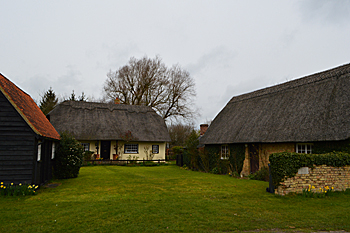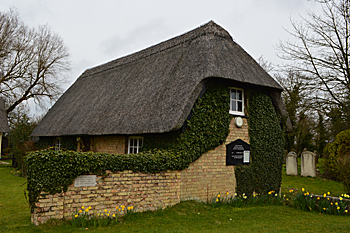Keysoe Row Baptist Chapel

Chapel House and the former Baptist chapel March 2016
A history of Keysoe Row meeting was written by the late H G Tibbutt in 1959. On 21st March 1808 a building of Joel Miles was registered for nonconformist worship [ABN1/1]. Deeds take the history of the chapel premises back to 1689. In that year a messuage in the endship of Keysoe called Keysoe Row, with a close of pasture called Home Close and other land in Keysoe Row were conveyed by Hugh Northfield of Keysoe, yeoman to two trustees as a marriage settlement for Northfield’s wife Elizabeth [X629/8-9].
In 1757 the daughters of John Northfield conveyed the cottage as well as some land to William Swepson of Keysoe, yeoman [X629/12-13]. Swepson sold the cottage and land to John Mayes of Keysoe in 1766 [X629/18-19]. Mayes left the cottage to his brother George in his will of 1773 [X629/20]. George, in turn, left it to his wife [X629/21]. In 1784 Thomas Mayes conveyed the cottage to John Grant of Great Barford [X629/22-23] and Grant conveyed it to Joel Miles in 1793 [X629/24-25].

Plaque on the wall of the chapel March 2016
Miles had joined Brook End meeting in 1773 but by 1801 had been separated from it for non-attendance. Miles’ building, probably a barn, was used as the meeting house throughout the life of the Keysoe Row church. The building was listed by English Heritage in August 1983 as Grade II, of special interest. It is timber-framed on a brick plinth and has been rendered and colour-washed on its eastern elevation, elsewhere it has been encased in yellow brick. It has a thatched roof.
The meeting was formally brought into being on 19th January 1812 with five members – Joel Miles, Thomas Partridge, John Robinson, William Hardwick and Ann Newell. The meeting was, from its outset, a Baptist meeting, unlike Brook End, which retained features of its genesis as an Independent church. All new members at Keysoe Row were baptised by full immersion in a pool behind the chapel. Not surprisingly Joel Miles became the first pastor, remaining in that position until his death in 1825. A list of members from 1812 to 1818 survives [X629/48] as does the church book from 1812 to 1972 [X629/47]. Miles devised the meeting to his wife Lydia in his will [X629/28] stipulating that on her death it was to be devised to William Crockford, Thomas Walker and John Whitney.
In 1828 Crockford, described as dissenting minister, and Walker, a farmer, devised the meeting as well as land and property in Hatch End to trustees: Thomas Howkins of Eaton Socon, farmer; Samuel Beal of Bletsoe, farmer; John bates of Nursen [Northamptonshire], farmer; George Game Day of Saint Ives [Huntingdonshire], attorney at law; William Goodliffe of Great Staughton [Huntingdonshire], farmer; William Lawton of Sharnbrook, grocer; Thomas Blott of Little Staughton, farmer; Joseph White of Bolnhurst, farmer; Francis Love of Keysoe, glazier; Stephen Dickins of Keysoe, bricklayer; John Gare of Keysoe, labourer; Samuel King of Hail Weston [Huntingdonshire], tailor and William Grey of Great Staughton, farmer [X629/30-31].
In the years between 1834 and 1848 twenty seven people joined Keysoe Row meeting. Between 1834 and 1871 or 1872 the pastor was John Woolston and it is known, from the church book of Thurleigh Baptist Church that on his resignation the Keysoe Row meeting closed until July 1872 when Thurleigh’s pastor George Chandler became the new pastor at Keysoe Row whilst continuing at Thurleigh. On the last Sunday in March 1851 a census was held of church attendance across the kingdom. John Woolston reported that at Keysoe Row there were eighty free seats. Attendance had been 30 in the morning, 40 in the afternoon and 20 in the evening, the average for preceding months being 35 per service.
Under George Chandler’s leadership 22 members were added to the meeting. In his 1959 history H G Tibbutt noted that American airmen from nearby Chelveston [Northamptonshire] preached at Keysoe Row. In the early 1970s the Baptist churches of Thurleigh, Little Staughton and Keysoe Row came under the supervision of Brickhill’s assistant minister, Rev Philip Campion. Little Staughton later withdrew from the arrangement but Thurleigh and Keysoe Row grew closer together and worshipped alternately in each village. In October 1978 the two churches became officially one as Keysoe Row and Thurleigh Baptist church [Z1801/2/1]. In 1987 it was reported that the chapel was in a “happy and fruitful relationship … the Row Chapel now goes from strength to strength under the leadership of its pastor Richard Ledger” [X349/3].
In July 2013 church members decided to sell the church premises and land at Keysoe Row East. The final service was held at the church on the 29th September 2013. Planning permission was sought to change use of the chapel building to residential in 2014 and consent was given for conversion to a one bedroom bungalow. The building was put up for sale and the sale was completed on 30th October 2015. In 2022, on the closure of the Keysoe Row and Thurleigh Baptist church, a final resolution was made that proceeds of sale of the Keysoe Row Chapel property be paid to the Baptist Union Corporation Ltd for the maintenance of the Keysoe Row Graveyard in perpetuity [Z1801/2/2].
.

The former Baptist church March 2016